Affiliate disclosure: This post may contain affiliate links. Please see our Privacy Policy.
When the peaches come in, our preservation kitchen goes into overdrive. Peaches are high sugar and high acid, which makes them perfect for canning, but that also makes them ideal for homemade peach wine. Once the canned peaches are put up, it’s time to break out the fermenter.
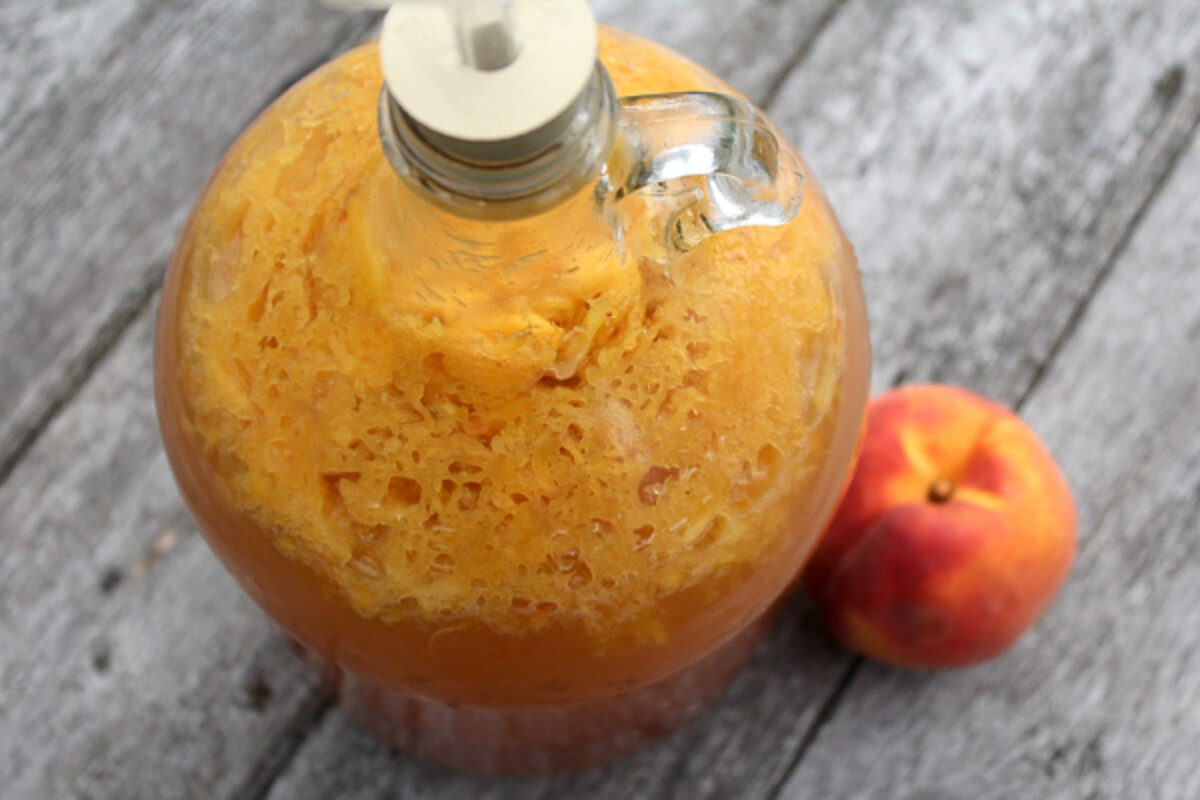
Vermont isn’t exactly the peach capital of the world, but with selective breeding practices, there are now new peach varieties for our zone 4 climates. I’m really excited, and I even have a few neighbors that have tasted their own homegrown peaches already. Our trees are still tiny sticks, but that doesn’t stop us from preserving a few crates of peaches from Pennsylvania Amish Country every year.
Home-canned peaches line our shelves, but I’ve also started canning peach pie filling, peach jam and peach scrap jelly from all the peels. Still, there’s only so much jam and preserves my family can eat in a year, so of course, I had to try my hand at homemade peach wine.
In the past, I’ve tried to use a small home juicer to extract peach juice for wine, but since peaches are so soft it just results in a peach puree. There’s a reason they don’t sell jugs of peach juice at the store, it comes out more like nectar than a straight juice. There is another way though…

This year I’m using a sugar juicing technique that I learned making rhubarb wine. Start by chopping the peaches and then pack them in sugar. The sugar will pull out the juice and break down the peach cells, making the juice more digestible for wine yeast.
When you first add the sugar to the peaches it’ll look a bit absurd. The peaches are more or less lost in the sugar, and it’s hard to imagine how this will turn into a juice. Patience…
All that sugar is doing the work for you, and within a few minutes, the peaches are already releasing their juice. After about an hour, a jar of sugared peaches has been transformed into a jar of sugar-sweetened juice perfect for peach wine.
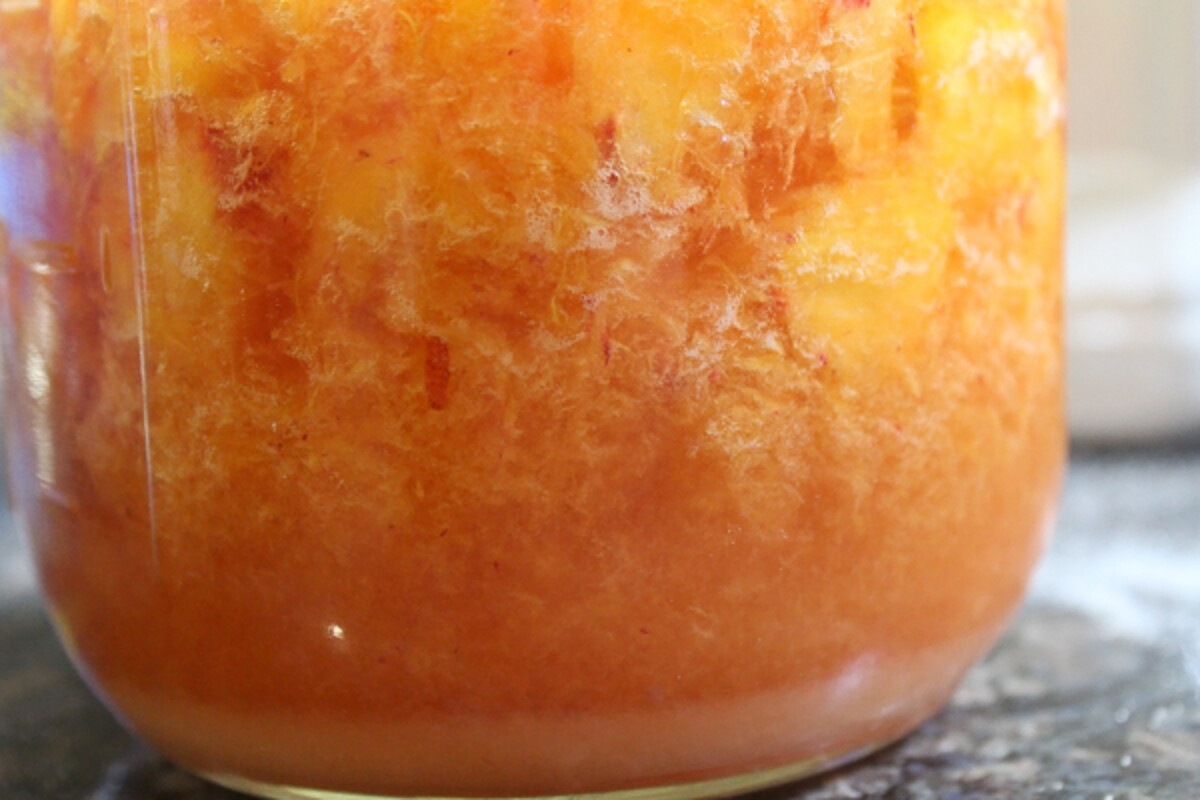
I was a bit hesitant to add too much sugar because I didn’t want to overwhelm the peach flavor. When I make my homemade peach jam, I use very little sugar to avoid overwhelming the peach flavor. My husband disagreed, and though he usually prefers dry wines, he thought a dry peach wine would be pretty unappealing. There has to be enough sugar in the fermenter to both create alcohol and leave a good bit of residual sweetness in the peach wine.
I went ahead and added a full 3lbs of sugar the first time I made peach wine, at his sweet suggestion. I’m using a champagne yeast with a high alcohol tolerance and though I didn’t measure the specific gravity, by taste and effect I’d say the finished wine came out both highly alcoholic and quite sweet. It’s VERY easy drinking, and you’re liable to end in a bit of trouble when you look over and the bottle’s empty before you know it.
For that reason, I’ve listed a sugar range on this recipe between 2lbs and 3lbs. Usually, I make fruit wines with 2 to 2.5 lbs of sugar per gallon, and peaches are quite sweet. Two pounds should yield a tasty balanced wine that’s not too sweet, and if you think it’s too dry for your palate when it’s finished fermenting you can always back sweeten it.
After I juiced the peaches with sugar, the remaining pulp was so pulverized that I just tossed it into the fermenter. I didn’t want to waste that peach flavor, but that was a mistake. Once the peach wine began fermenting, the pulp all floated to the top. While it looked pretty pulverized when I poured it in, it quickly formed a dense mat at the top of the fermenter. Next time, I won’t add in the peach pulp, just the sugar extracted juice.
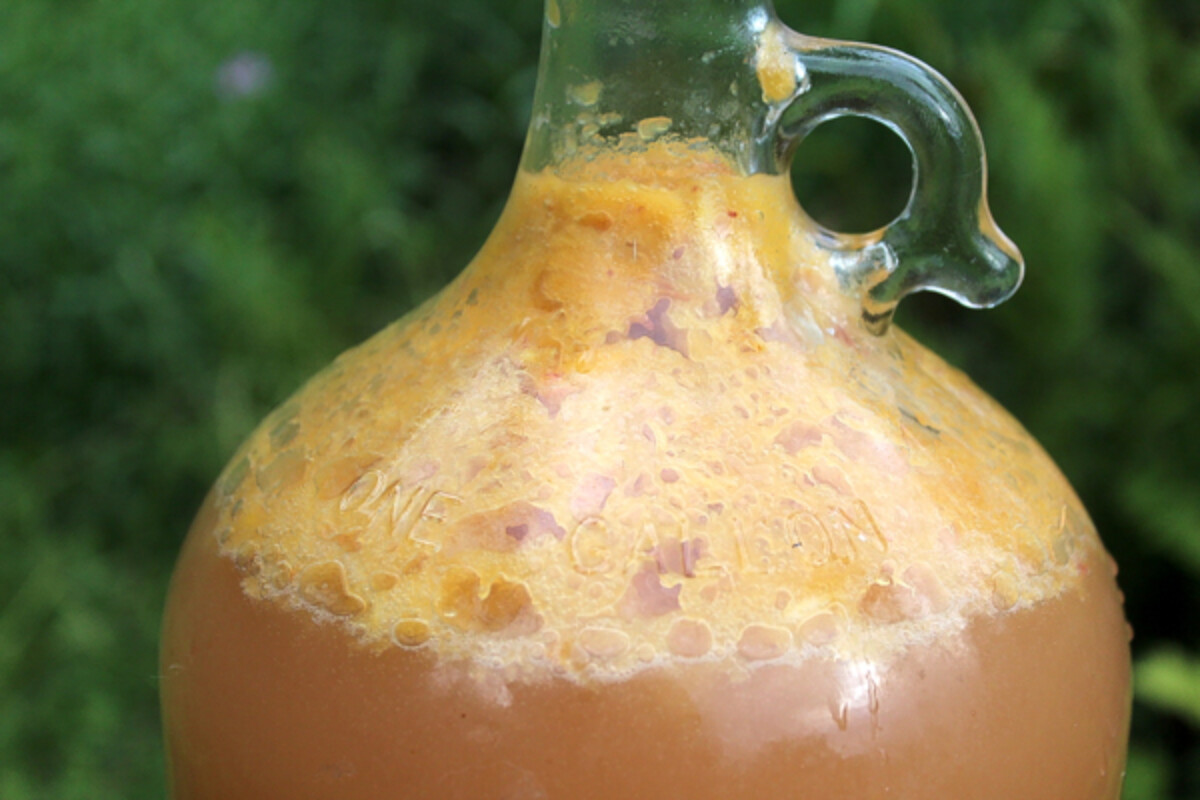
In my case, it worked out just fine and that peach pulp never managed to clog the water lock and create a big mess. There was enough headspace, and I poped it open to shove the peach chunks down a few times (with a sterilized implement). No worries, and no trouble, but I still will filter out the pulp next time.
In this peach wine recipe, I’m using the same yeast that I generally use for my small-batch meads. It’s Premier Blanc wine yeast which used to be called champagne yeast. It has a high alcohol tolerance and produces tiny bubbles in the finished wine like champagne. Since this type of yeast is often used to restart sluggish fermentation, it’s also a great choice if you want to make sure a homemade wine gets started right the first time.
Feel free to choose a different wine yeast, but be sure to dissolve the yeast in water and allow it to bloom for 5-10 minutes before adding it into the peach wine base. The yeast granules are hibernating and throwing them right into a sugary solution before allowing them to rehydrate can shock the yeast.

Other than wine yeast purchased specifically for home brewing, I generally like to make wine with what I have in my kitchen. I avoid yeast energizers, acid blends, tannin powders and the like. For acid, I add in a bit of lemon juice. For tannin, I’ll add in a few currant leaves or grape leaves, or a black tea bag. I like to let my wines ferment completely and then carbonate slightly in the bottle, rather than ending the fermentation with Camden tablets.
That said, winemaking additives do have their place and they make a far more reliable brew than kitchen pantry alternatives. If you do want to use winemaking additives instead, here’s where to find them:
- Pectic Enzyme for breaking open the peach fruit cells and help the natural pectin to separate and settle. Use about 1/2 tsp per gallon.
- An acid blend to decrease the overall pH. How much to add depends on the type of wine, and here’s a good primer on using acid blends in home winemaking.
- Yeast Nutrient to feed the little beasties and give them the micronutrients that help them thrive. Add 1 tsp per gallon of wine.
- Tannin to give the sweet wine a bit of astringency and balance the flavor. A little goes a long way, and 1/8 to 1/4 tsp is all you need.
- Potassium Sorbate and Camden tablets (potassium metabisulfite) to completely end the fermentation and stabilize the wine before bottling for a still wine with no carbonation.
In some of my homemade wines, I make a conscious choice to use winemaking chemicals, as I did in this lemon wine. I wanted a really clean flavor, so instead of raisins, I added yeast nutrient. That said, I’ve never used potassium sorbate or Camden tablets. I have no desire to eat preservatives in my food, and I’m not happy when they sneak into my favorite foods. There’s no way I’m going to consciously put them into my homemade wine.
To get started brewing, the only specialized equipment and ingredients you need is the wine yeast, a carboy, rubber stopper, and an airlock. This kit has everything you need except the yeast for about $10. Beyond that, an Auto Siphon is wicked helpful for bottling and worth the investment if you plan on making more than one batch of homebrew in your lifetime.

The whole process for making peach wine is pretty simple. Place the sugar juiced peaches, lemon juice, tannin source, and water are in the fermenter and seal it with a water lock. Allow it to bubble away for about 10-14 days. This is known as primary fermentation and is the most active stage of fermentation. The bubbles should be coming strong, and the water lock will be burping almost continuously once the ferment gets going.
Once things settle down after the primary fermentation step, siphon the wine over into a clean container, leaving any sediment behind. This is where it’s really helpful to have a second fermentation vessel. Racking the wine into secondary it’s strictly required, but it is highly recommended. All the sediment at the bottom can create off-flavors in a finished wine, and it’s best to move the wine off of them if possible. Racking the wine into secondary also helps it clear.
If you choose not to rack, know that any chunks of peaches in the wine can cause contamination over long periods of time. They’re fine in there for just the primary ferment, but after that, anything above the waterline may mold and should be removed. If you’re not going to rack the wine into secondary, make sure you’ve really filtered out all the peach chunks before the wine goes into the carboy.
Once the wine is in secondary, allow it to bubble away for at least 6 weeks until fermentation slows or stops. More time isn’t harmful, provided the water lock still has water in it and stays sealed (it can evaporate if left for extended periods). Leaving the wine in secondary for 3-6 months will actually improve its flavor, and if you’re patient I’d suggest that route.
Either way, after a secondary of at least 6 weeks (or 6 months), us an Auto Siphon to bottle the wine, leaving the yeast sediment behind. You can re-use wine bottles from previous batches, but be sure to clean them out thoroughly with a one-step sanitizer. Always use new corks when bottling (and a wine bottle corker). If you don’t have a bunch of wine bottles on hand (or you’re not confident that you can get them really clean), they’re also available here.
Allow the peach wine to bottle age for at least a month, but preferably a year or more for best flavor.
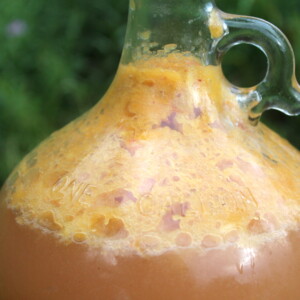
Peach Wine
Equipment
- Wine Tannin 1 oz, Pectic Enzyme 1 oz, Acid Blend 2 oz Bundle
Ingredients
- 2-3 lbs peaches, chopped
- 2-3 lbs sugar
- 1/8 tsp Tannin Powder, or 1 Cup of Strongly Brewed Black Tea
- 2 tsp Acid Blend, or 2 Tbsp. Lemon Juice
- 1 tsp Yeast Nutrient, or 1/8 cup raisins
- 1 packet Premier Blanc Wine Yeast
Instructions
- Chop the peaches into a large bowl or half-gallon mason jar. Cover the peach slices with sugar, and stir every few minutes. The sugar will extract the peach juice in about 1-2 hours.
- Drain the peach juice into a fermentation vessel, and then use water to wash the peach pulp to remove the last bits of sugar and peach juice. Pour the water through a fine-mesh strainer and fill the fermenter to about 3/4 full, leaving space for the remaining ingredients.
- Brew a cup of strong black tea, remove the tea bag and add about 1/2 cup of the strongly brewed black tea into the fermenter. (Or just add winemaking tannin.)
- Add 2 tbsp of lemon juice into the fermenter. (Or just add 2 tsp acid blend for winemaking)
- Add raisins or yeast nutrient, but keep in mind if you add raisins they will float and you must filter them out before secondary to prevent surface mold down the line.
- Open the yeast packet and allow it to bloom in about 1/4 cup of lukewarm water for 5 to 10 minutes. Add the yeast into the fermenter. One packet is enough for 5 gallons of wine, so you can save some for other batches, or use the whole thing if you’re not planning any other brewing in the near future.
- Add water to fill the fermenter to within a few inches of the top. Cap with a rubber stopper and give the whole thing a shake, careful not to drop it. Or, for the more conservative, use the handle of a long kitchen spoon to stir it up.
- Cap with an airlock and allow the mixture to ferment for about 10-14 days. When the fermentation begins to slow, siphon the mixture over into a clean carboy, leaving any sediment behind.
- Re-cap with a water lock and ferment for at least another 6 weeks, preferably longer such as 3 to 6 months. It may finish and clarify sooner, depending on your local temperature.
- Bottle the peach wine in clean, sterilized wine bottles with corks. Allow the peach wine to bottle age for at least 1 month, but preferably up to a year before drinking.
Notes
More Winemaking Recipes
Looking for more easy winemaking recipes? Try any of these homemade country wines:
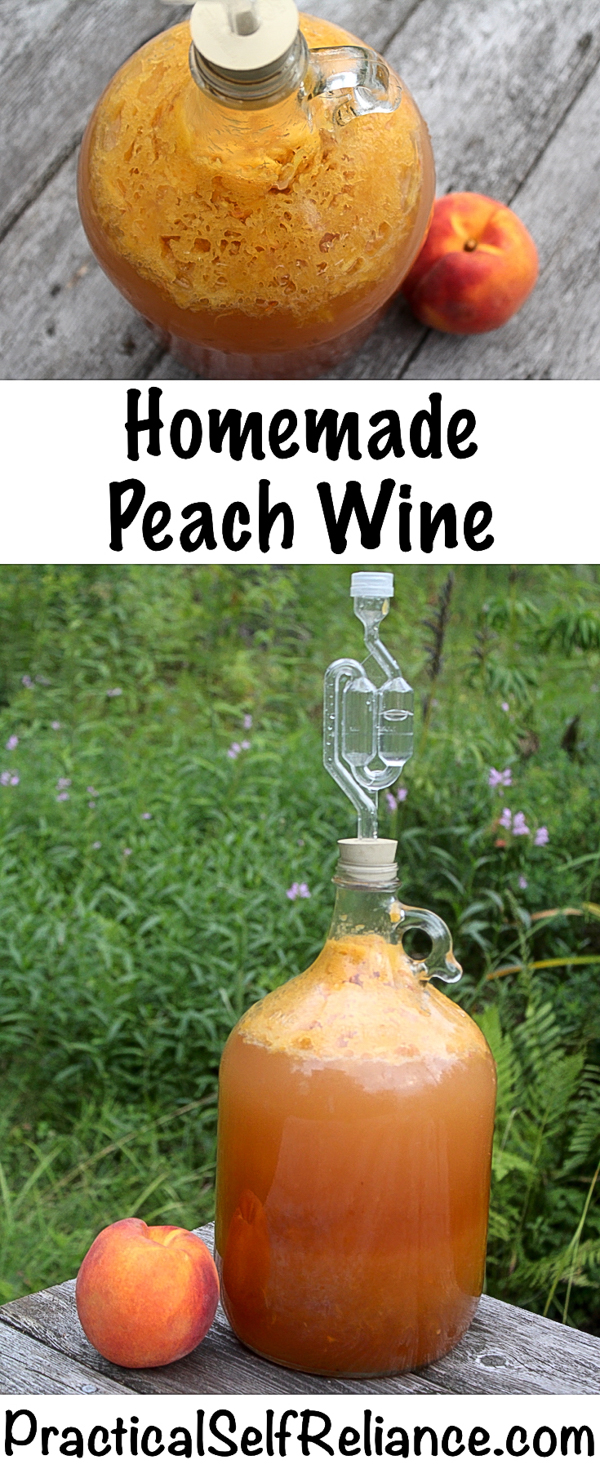



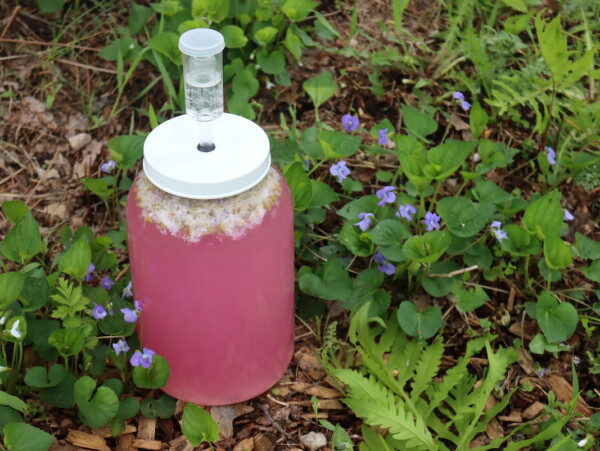










Sounds promising, I am going to try that. I got a lot of peaches and nectarines, I have no idea what to do with them (there are no jam eaters in my family), so I’ll try making peach and nectarine wine instead. I didn’t even know it’s possible,
This one’s so good too!
Hi Ashley. I have 5 quarts of canned peaches dated 2014 and 2016. And would like to make wine from them. Is it possible?
Yup, that’s totally fine. Making wine from canned fruit works just fine. Use the juice as well as the whole fruit. Often there’s a bit of sugar in the peaches when canned, so you could decrease the sugar by a bit, but not much, or just leave it as is. Unless they’re canned in heavy syrup, there’s not all that much actual sugar in those jars. Enjoy!
Would it work if I make the fruit sugar mix it boil it cool it then freeze it to start the wines at a later date?
You can mix the fruit and sugar, and then freeze. That’ll work fine. I don’t recommend boiling it though, as cooking the fruit really dramatically changes the flavor. You really want fresh fruit (or frozen fruit) rather than cooked fruit for wine.
My peach wine only bubbled for 5 days. Do i need to add more yeast
Sometimes the fermentation goes faster than others, but no, you don’t need to add more yeast. They’re still in their working, they’re just slowing down so it’s harder to see now. Rack the wine to a clean container, leaving sediment and peach chunks behind. In secondary, it won’t look like it’s doing much, but it still is fermenting slowly and needs that time. Enjoy!
I did exactly to recipe x3..the bubbling was sluggish and only lasted 5 days then stopped..the last batch of wine i did was more active..i used bread yeast for that one but wine yeast 3 pks for this one..am i doing something wrong? Pls help..do i need to add more yeast
Nope, no need to add more yeast. Sometimes it just ferments faster than others, and that’s totally normal. Just continue with the recipe, it is still fermenting, just not as visibly.
Just made 3 gallons of peach wine using your guidance. I love the fact that you taught what to use in place of the Chemicals. Will try to write again in a year to let you know if it turned out alright. Thank you
Wonderful, I really hope you enjoy it!